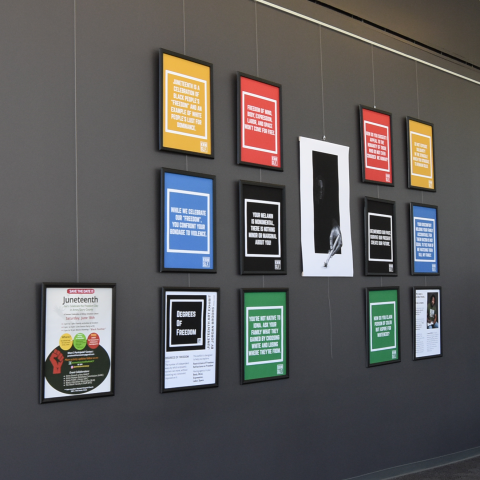
A Library Exhibit on Black Freedom
by Sheila Schofer
The Library has a beautiful entryway with a striking charcoal gray wall that provides a perfect backdrop for exhibits.
The exhibit on display currently is by artist Jordan Brooks and ties in to Juneteenth programming and events happening in the library and the broader community.
The white lettering pops against orange, yellow, green, blue and black backgrounds creating an eye-catching contrast. The words themselves make a statement, too, as they urge viewers of all backgrounds to reflect on the statements and explore their personal reactions.
The artist statement explains the exhibit: “Degrees of Freedom'' by Jordan "KNWSLF" Brooks is an inquiry-based installation. All are encouraged to identify ways the United States historically and persistently restricts freedom for Black Americans. All are encouraged to familiarize themselves with Black scholars, Black creators, and Black curators of culture and reflections on freedom. Black people are encouraged to celebrate Juneteenth. White, Indigenous, and Non-Black POCs are encouraged to reconcile how pursuit of their own freedom has come at the expense of Black people's agency in their body, mind, expression, labor, and space.
I reflected on the statements in the frames for myself, with colleagues, and with library patrons. Art is meant to evoke a response and that response will vary for each art piece and each individual. Some appreciated that the statements invited visitors to pause and think. Some felt uncomfortable, even angry and targeted.
In a conversation with one patron, I recalled the book White Fragility by Robin DiAngelo and a few take-aways that had helped me to recognize some harsh realities about myself and to get better perspective. That white people aren’t practiced in talking openly about race or at recognizing the privileges they have taken for granted. That white people often withdraw to an individualist attitude—a “not me” because I marched in the civil rights movement, I have black friends, my kids go to a diverse school. That white people default to an oversimplified good/bad binary where one is only racist or “bad” if they commit an outright intentional racist act; If they don’t intentionally commit blatant racist acts then they are “good” and absolved from all further learning or action.
I think many of these defense mechanisms were at play and resulted in the hurt or even angry feelings I heard expressed. As I shared my experiences and vulnerability with this particular patron I felt a new understanding developing between us.
That kind of understanding is a big part of the library’s mission: We connect you to the world of ideas.
Currently the library has a display in the Adult Services area with materials about Juneteenth and the history of enslavement and civil rights in America. We also have books chosen with partners from the ISU Office of Diversity Equity and Inclusion as part of our evolving Black Book Nook reading list. Recently staff from across the library collaborated on identifying some 5000 + items to be stocked on our Bookmobile as part of the community Juneteenth celebration. They selected materials by black authors, illustrators and creators, emphasizing not just history but a range of experiences, everyday stories and joyful celebration. The goal was to promote the library’s diverse collections but more importantly, to create a space that centered black experiences so that folks going on board the Bookmobile at the event could see themselves represented and feel the power of inclusion in the space.
This is what we strive for in our entire library. A space where all see themselves reflected and feel included and represented—in the space, through the people present, and in the services, collections, programming and exhibits. The Library outlined goals of Inclusion, Equity, Access Wellness, Civic Engagement and Professional Development in our Strategic Plan and recognize that to truly reach these goals we have to continue our reflection and learning, amplify under-represented voices, build relationships, foster dialog, collaborate with communities of color and LGBTQIA+, and center experiences beyond the white experience.
We have work to do but hope that our entire community is with us on the journey.